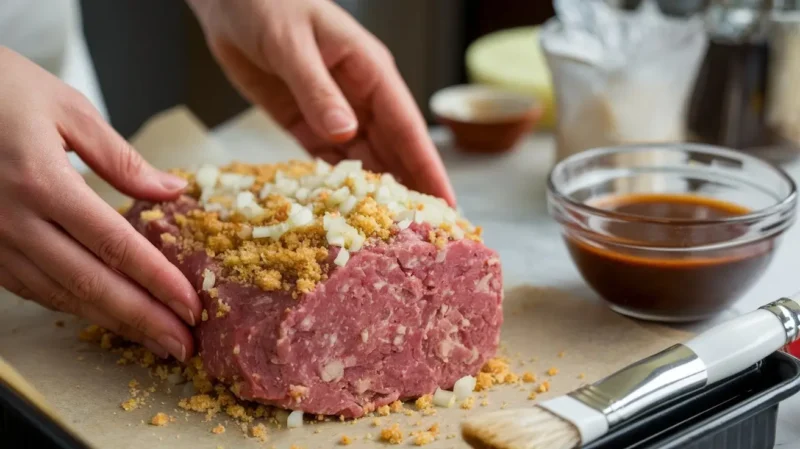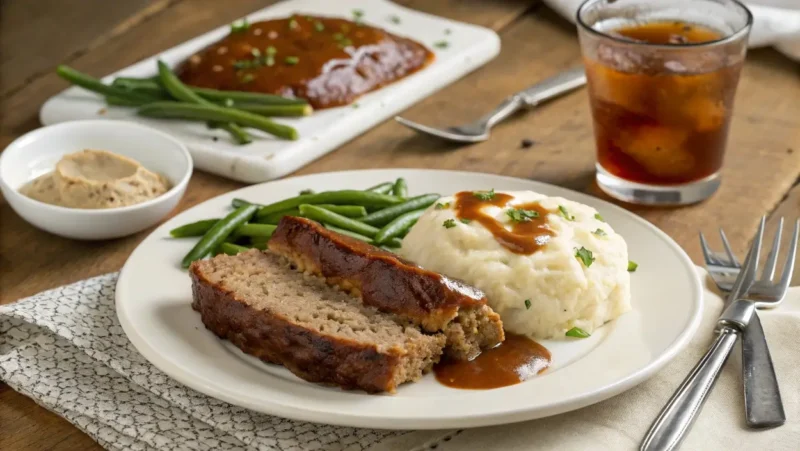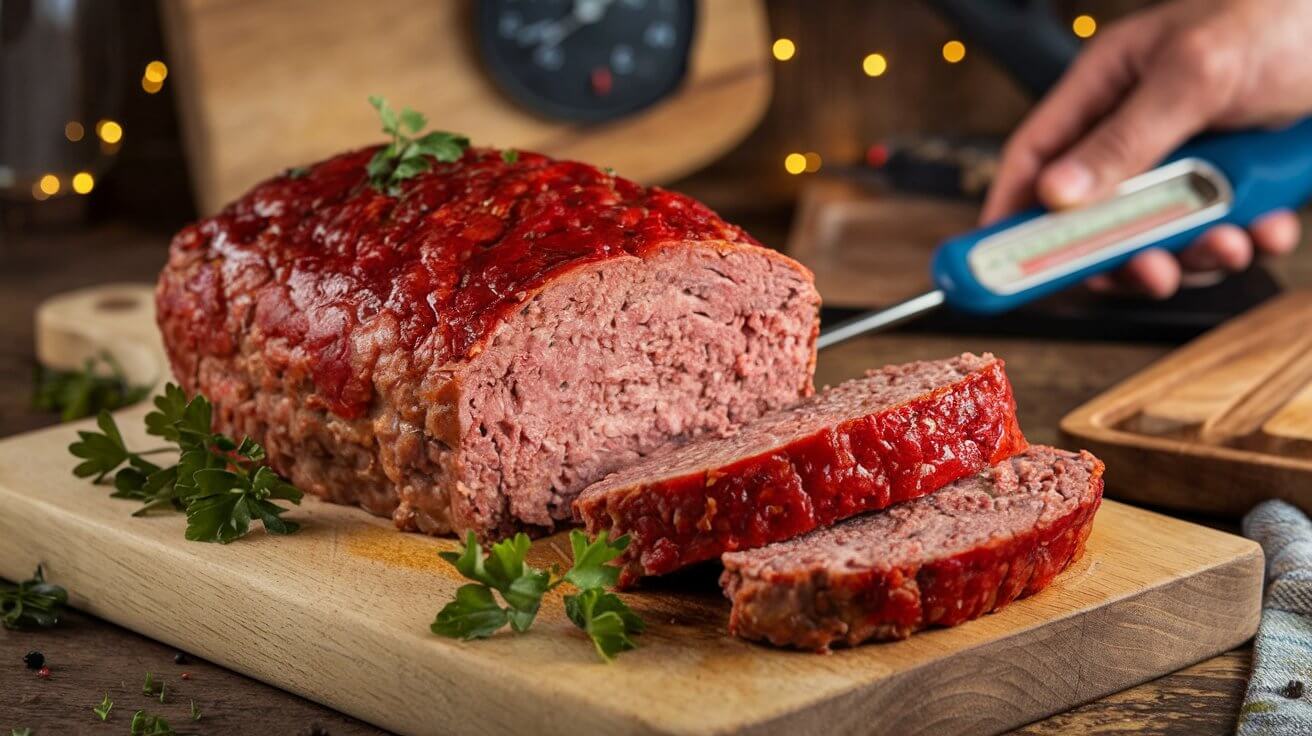Ah, meatloaf! It’s the classic comfort food that takes us back to family dinners and cozy kitchens. But what exactly is it? At its core, meatloaf is a dish made of ground meat, usually beef, mixed with breadcrumbs, eggs, and a variety of seasonings. The mixture is shaped into a loaf (hence the name) and baked to perfection. If you’ve ever wondered how to cook 1 lb meatloaf just right, you’re diving into a tradition that’s as versatile as it is delicious. While it might sound simple, it’s a dish steeped in both history and endless possibilities.
Every household has its unique twist, some include vegetables, others add cheese, and a few might even sneak in unexpected spices. But no matter the recipe, one thing is certain: cooking it just right is essential. Why? Because overcooking leaves it dry and crumbly, while undercooking is a health risk.
Table of Contents to cook 1 lb meatloaf
The Importance of Proper Cooking to cook 1 lb meatloaf
Cooking meatloaf isn’t just about taste; it’s also about safety. Did you know that ground beef needs to reach an internal temperature of 160°F to be safe to eat? That’s not just a preference; it’s a guideline from the USDA. A well-cooked meatloaf is juicy, tender, and flavorful, a feat made achievable with just a few simple steps.
If you love experimenting with flavors, you might also explore meatloaf seasoning ideas for enhancing your dish’s profile. Perfect seasoning brings out the meat’s natural flavor while creating a robust dining experience.
“Perfectly cooked meatloaf isn’t just a dish; it’s an experience. Get the timing right, and you’re halfway to culinary bliss!”
Factors That Affect Cooking Time to cook 1 lb meatloaf
Cooking time for meatloaf isn’t a one-size-fits-all scenario. A lot depends on these key factors:
- Thickness of the Loaf: A thicker loaf takes longer to cook. Think about it, it’s like baking a cake. A deeper pan means more time in the oven.
- Oven Temperature: Lower temperatures, like 350°F, result in a longer cooking time but often a juicier meatloaf. Higher temperatures cook it faster but can dry it out if you’re not careful.
- Meat Composition: Using leaner meat like ground turkey or chicken can reduce cooking time because they have less fat. Meanwhile, fattier meats like ground beef or pork retain moisture longer but need careful monitoring to avoid overcooking.
- Add-Ins: Mixing in wet ingredients like diced onions or ketchup increases moisture and can lengthen the cooking time slightly.
- Cooking Method: Traditional baking or trying innovative approaches, like smoked meatloaf, can impact overall cooking times.
So, what’s the golden rule for cooking a 1 lb meatloaf? Let’s dive deeper.
How Long Do You Cook 1 lb of Meatloaf?
For a 1 lb meatloaf, the optimal cooking time varies depending on the oven temperature:
- At 350°F: Cook for about 45-50 minutes. This temperature allows the meat to cook evenly and retain its moisture.
- At 375°F: Bake for 40-45 minutes for a slightly faster result while still achieving good moisture retention.
- At 400°F: Cook for 35-40 minutes, but keep an eye on it, higher heat means you risk drying it out if you’re not careful.
No matter the temperature, the internal temperature must reach 160°F. That’s non-negotiable for food safety. A trusty meat thermometer is your best friend here.
Tip: Don’t eyeball it! A meat thermometer ensures you’re not just guessing whether your meatloaf is done.
Recommended Oven Temperatures to cook 1 lb meatloaf
Choosing the right oven temperature can make or break your meatloaf. So which is best?
- Low and Slow (350°F): This is ideal for those who want a tender, juicy meatloaf. The extended time allows the flavors to meld beautifully.
- Moderate Heat (375°F): A happy middle ground, offering a balance of speed and moisture retention.
- Hot and Quick (400°F): Perfect if you’re in a hurry, but be cautious not to overcook it.
Personally, I always recommend 375°F for a 1 lb meatloaf. It strikes that perfect balance of cooking time and tenderness, giving you a melt-in-your-mouth texture without the wait.
Perfecting the Cooking Process and Common Variations to cook 1 lb meatloaf
Using a Meat Thermometer for Perfect Results
When it comes to cooking a perfect 1 lb meatloaf, a meat thermometer isn’t just helpful, it’s essential. It’s the ultimate tool to ensure you’re neither overcooking nor undercooking your dish. But how do you use it correctly?
Insert the thermometer into the center of the meatloaf, the thickest part of the loaf. Make sure it doesn’t touch the bottom of the pan or any filling that might skew the reading. Your goal is an internal temperature of 160°F. This ensures the meatloaf is safe to eat while still being juicy.
Pro Tip: If you don’t have a meat thermometer, check for clear juices running out when you slice into the meatloaf. It’s a visual cue, but not as reliable as a thermometer.
Step-by-Step Guide to Cook 1 lb Meatloaf

Cooking a 1 lb meatloaf doesn’t have to feel like rocket science. With a simple step-by-step approach, you can nail it every time. Let’s break it down:
- Preheat Your Oven: Set your oven to 375°F for a balance of speed and juiciness.
- Prepare Your Meatloaf Mixture: Combine your ground meat, breadcrumbs, eggs, diced onions, and seasonings. Don’t overmix, just until the ingredients are evenly combined.
- Shape the Loaf: Place the mixture on a lined baking tray or loaf pan and shape it into an even, compact loaf. A uniform thickness ensures even cooking.
- Add the Glaze: Spread a layer of ketchup, BBQ sauce, or a mixture of both over the top. This caramelizes beautifully while baking and adds flavor.
- Bake It: Place the meatloaf in the oven and let it bake for 40-45 minutes.
- Check the Temperature: About 35 minutes in, check the internal temperature using your meat thermometer.
- Rest the Meatloaf: Once it hits 160°F, remove it from the oven and let it rest for 5-10 minutes. This helps the juices redistribute, keeping your meatloaf moist.
“The secret to a great meatloaf isn’t just the recipe, it’s the patience to let it rest after cooking. Good things come to those who wait!”
Variations on the Classic Meatloaf
Let’s face it: one size doesn’t fit all when it comes to taste. That’s why meatloaf is such a beloved dish, it’s endlessly customizable. Here are a few popular variations you can try:
- Classic Beef Meatloaf: The tried-and-true recipe, using 80% lean ground beef for the perfect balance of fat and flavor.
- Turkey Meatloaf: A lighter alternative that cooks slightly faster due to lower fat content.
- Vegetarian Meatloaf: Made with lentils, mushrooms, or even chickpeas, this option is packed with nutrients and flavor.
- Stuffed Meatloaf: Add a surprise layer of cheese, spinach, or hard-boiled eggs inside the loaf for an extra wow factor.
Each variation might slightly adjust the cooking time, especially when using leaner proteins like turkey or plant-based ingredients. Always check the internal temperature to ensure it’s cooked through, 165°F for turkey or vegetarian options.
Baking vs. Slow Cooking: Which is Better?

Have you ever wondered if there’s a better way to cook meatloaf than in the oven? Slow cooking is an option that’s growing in popularity, and for good reason. Let’s compare:
Baking in the Oven:
- Pros:
- Crispy edges and caramelized glaze.
- Quicker cooking time (40-50 minutes for 1 lb).
- Easy to monitor with a thermometer.
- Cons:
- Requires constant temperature monitoring.
- Risk of drying out if overcooked.
Slow Cooking:
- Pros:
- Retains moisture beautifully.
- No need for constant monitoring, just set it and forget it.
- Flavors have more time to develop.
- Cons:
- Takes longer (around 4-6 hours for 1 lb meatloaf).
- Doesn’t achieve crispy edges unless finished in the oven.
So, which method should you choose? If you’re short on time, stick with the oven. If you’re prepping ahead and want maximum tenderness, the slow cooker is a great choice.
How to Tell If Meatloaf Is Done
Have you ever sliced into a meatloaf, only to find it undercooked or, worse, dry as a bone? Let’s make sure that never happens again.
Key Indicators of a Fully Cooked Meatloaf:
- Internal Temperature: Always rely on your thermometer for an accurate reading.
- Texture: Properly cooked meatloaf will feel firm but not hard to the touch.
- Juices: When you slice into it, the juices should run clear, not pink.
If your meatloaf isn’t done but is browning too quickly on the outside, cover it loosely with aluminum foil and continue baking. This traps moisture and prevents the top from burning.
“Remember, good cooking is a mix of science and instinct. A thermometer gives you the science, but trust your senses too!”
Adjusting for Higher Altitudes
Cooking meatloaf in a high-altitude area? You might need to tweak a few things. Higher altitudes often require longer cooking times because the boiling point of water is lower. This means moisture evaporates more quickly, which can dry out your meatloaf.
Tips for High-Altitude Cooking:
- Reduce oven temperature by 25°F and extend cooking time slightly.
- Add a bit more moisture to your mixture, extra ketchup, eggs, or even a splash of milk.
- Keep a close eye on the internal temperature to avoid overcooking.
Resting, Serving, and Frequently Asked Questions to cook 1 lb meatloaf
Resting Time After Cooking
One of the most overlooked steps in cooking meatloaf is letting it rest. It might seem like a small detail, but trust me, it’s a game-changer. When meatloaf comes out of the oven, the juices are still bubbling and moving within the loaf. If you slice it immediately, all those delicious juices will spill out, leaving your meatloaf dry.
Letting it rest for 5-10 minutes allows the juices to redistribute throughout the meatloaf, ensuring every bite is moist and flavorful. Cover it loosely with aluminum foil during this time to keep it warm. Think of it like letting a steak rest, same principle, just a loaf-shaped version.
What Happens If You Undercook Meatloaf?
Undercooking meatloaf isn’t just a culinary mishap, it can be downright dangerous. Ground meat can harbor bacteria like E. coli or salmonella, which are only killed at safe temperatures.
If you suspect your meatloaf isn’t fully cooked (maybe it’s still pink in the middle or feels too soft), don’t panic. Pop it back into the oven and cook until the internal temperature reaches 160°F.
“It’s always better to be safe than sorry when it comes to cooking meat. A few extra minutes in the oven beats a trip to the doctor!”
Tips for Juicy Meatloaf Every Time
Let’s get to the good stuff, secrets for a meatloaf that’s moist, tender, and downright addictive.
- Don’t Overmix: Mixing your meatloaf too much can make it dense and rubbery. Combine ingredients just until they’re incorporated.
- Use the Right Fat Content: Ground beef with 80% lean and 20% fat strikes the perfect balance.
- Add a Panade: What’s a panade? It’s a fancy term for mixing breadcrumbs with milk. This keeps your meatloaf moist and prevents it from falling apart.
- Top with Glaze: A good glaze locks in moisture and adds a sweet-savory flavor that’s irresistible. Ketchup, BBQ sauce, or even a honey-mustard mix works beautifully.
Customizing Your Meatloaf
Experimenting with meatloaf can be as creative as it is fun. From adjusting flavors to testing new cooking techniques, there’s always a way to elevate your dish.
- Seasonings & Spices: Refer to this meatloaf seasoning guide for ideas on enhancing flavors.
- Smoking the Meatloaf: Trying a smoked meatloaf recipe can add a whole new dimension of taste.
Serving Suggestions for Meatloaf

What’s a great meatloaf without delicious sides? Here are a few classic pairings to round out your meal:
- Mashed Potatoes: Creamy and buttery, they’re the ultimate comfort food combo.
- Roasted Vegetables: Carrots, Brussels sprouts, or green beans add color and nutrition.
- Mac and Cheese: For a truly indulgent meal, pair your meatloaf with gooey, cheesy pasta.
- Salad: A crisp green salad with a tangy vinaigrette balances the richness of the meatloaf.
Pair your meatloaf with complementary sides like mashed potatoes, roasted veggies, or even creamy chicken and rice for a hearty and balanced meal.
Frequently Asked Questions (FAQs) to Cook 1 lb Meatloaf
How long do you cook 1 lb of meatloaf at 350°F?
For a 1 lb meatloaf, cook it at 350°F for 45-50 minutes. Always check the internal temperature to ensure it’s 160°F.
Can you freeze uncooked meatloaf?
Yes, you can! Wrap it tightly in plastic wrap and foil, then freeze it for up to 3 months. When ready to cook, thaw it in the fridge overnight and bake as usual.
What’s the best glaze for meatloaf?
Ketchup is a classic, but you can also use BBQ sauce, honey-mustard, or even a balsamic reduction for a unique twist.
How do you keep meatloaf from falling apart?
The secret is in the binders, use eggs and breadcrumbs to hold everything together. Don’t skimp on these ingredients.
Cooking 1 lb of meatloaf to perfection is a balance of science and art. From choosing the right temperature to letting it rest after baking, every step matters. With this guide, you’ll master the techniques to create a meatloaf that’s juicy, flavorful, and sure to impress. Whether it’s a weeknight dinner or a special family meal, your perfectly cooked meatloaf will be the star of the show.
“Cooking is love made visible, so go ahead and pour your heart into that meatloaf!”

